The guava is subject to attack by several kinds of insects. Among the more important are guava whitefly, red-banded thrips, guava fruit moth, Caribbean fruit fly, mealybugs and several species of scales. Detailed life history and effective control measures for most of these pests still remain to be worked out.
Recommendations for effective control of insect pests are limited because only a few insecticides have been registered for use on guava. Some of these are not approved for use when fruit is present. Some of the most effective materials have not been approved. At the present time, EPA listings indicate that Pyrellin, Provado, Spin Tor 2SC, Azatin, Mycrotrol, Malathion, Logic, Endeavor, Surround, Esteem, Extinguish, Amdro, Knack, Floramite, Tame, Savey, Talstar, insecticidal soap, Bacillus thuringiensis, and Pyrenone are insecticides that are registered for use on guavas. Bacillus thuringiensis (Dipel) 2X, 4L is labeled for use on hornworms, leafrollers, omnivorous loopers, and loopers.
The user must read the label carefully for more specific details on use. The local UF/IFAS Extension office or farm chemical dealers may be able to provide more specific details on pest control materials.
Insects on Flowers and Fruits
Guavas are a crop in which very little is known about the control measures concerning pests that attack them. It is the responsibility of the grower to take utmost care in selecting pesticide materials that are labeled for use in this crop. Even though certain insecticides are approved by the EPA for use on guavas, only certain labels that contain these specific insecticides may have guavas listed. If further information is needed contact your local UF/IFAS Extension agent.
Under the FIFRA amendment of 1978 the grower may use a material (insecticide) that is legal and EPA approved for a pest on a crop for other non-listed pests as long as the user follows the label directions and rates for the approved pest.
The following materials are legal for use on guava in Florida (Table 1):
- Bacillus thuringiensis (several trade names)- for use against certain Lepidopterous caterpillars.
- Pyrellin (pyrethrins + rotenone)- for use against aphids, caterpillars, fruit-flies, leafhoppers, mites, thrips, weevils, and whiteflies at 1 - 2 pts per acre. No waiting period to harvest.
- Pyrellin, Provado, Spin Tor 2SC, Azatin, Mycrotrol, Malathion, Logic, Endeavor, Surround, Esteem, Extinguish, Amdro, Knack, Floramite, Tame, Savey, Talstar
Caribbean Fruit Flies
The Caribbean fruit fly, Anastrepha suspensa (Loew), is also called the Caribfly and guava fruit fly. The adults are small yellow-brown flies 1½ to 2 times larger than a house fly, with rather long, patterned wings (Figure 1A and B). Eggs are laid singly and hatch in about 2–3 days. The larval period lasts 10–14 days (Figure 2), and pupation is in the soil under the tree (Figure 3); adults emerge after 15–19 days. These stages are prolonged in cool weather. A parasitoid Diachasmimorpha longicaudata (Figure 4) was introduced into Florida from Mexico and Hawaii in 1972 by Baranowski to decrease the fruit fly populations, and it can still be found attacking Caribbean fruit fly. These parasitoid wasps reproduce by laying their eggs inside fruit fly larvae. They are associated with symbiotic viruses (rhabdoviruses) that alter host metabolism and development to promote successful development of the wasp embryo. In the case of D. longicaudata, this virus is present some of the time, but not required for successful parasitism.
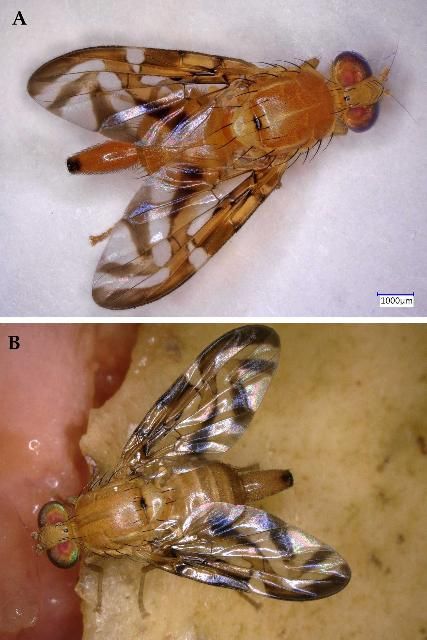
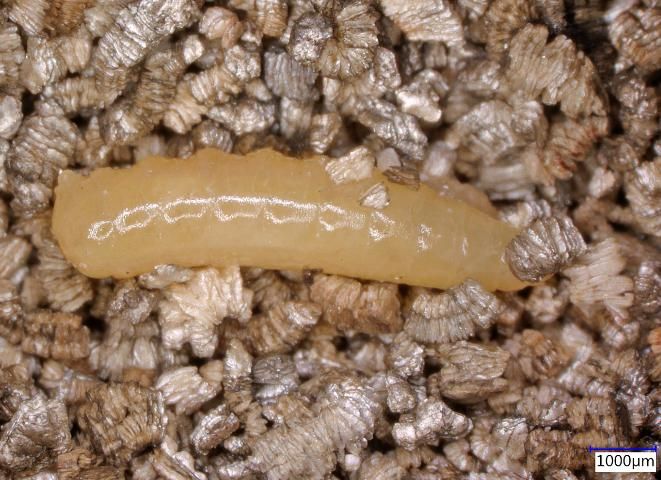
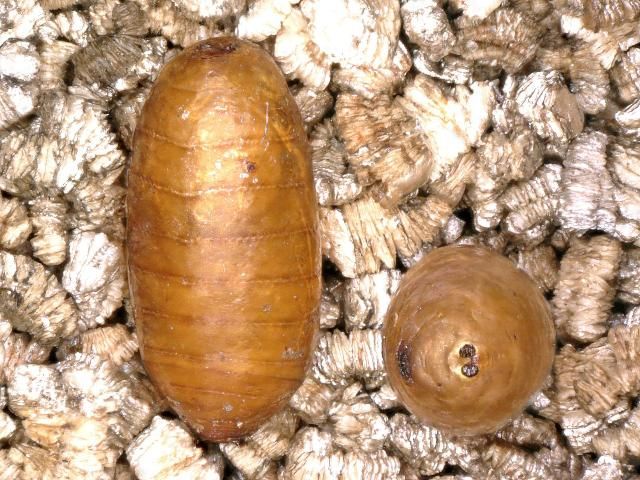
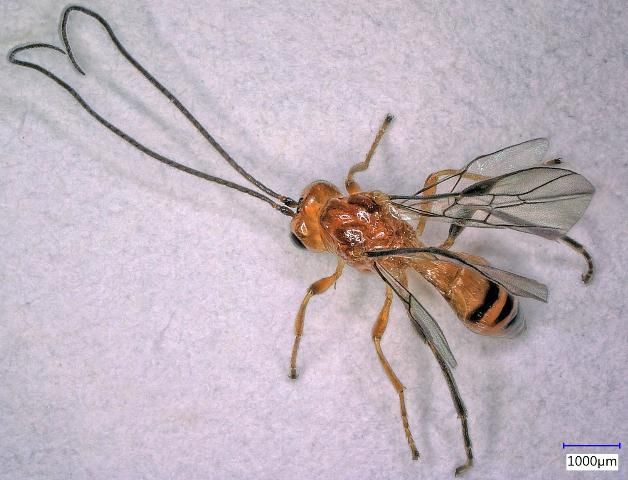
The Caribbean fruit fly infests mostly mature to overripe fruits (Figure 5). Infested guava fruit show signs of fruit fly feeding, and the fruits are softer on one side. Larvae can be seen tunneling through the pulp.
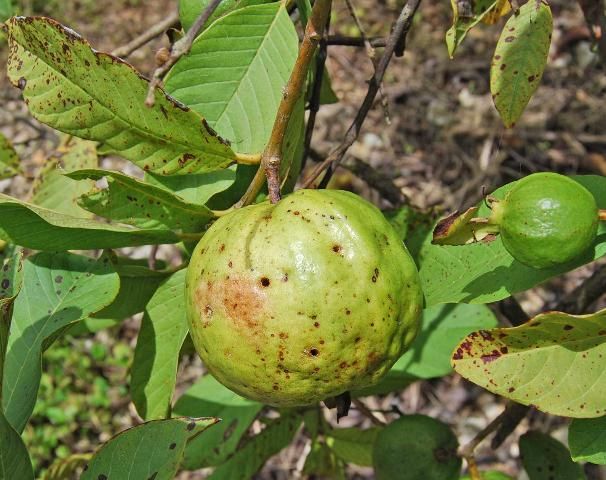
Moths and Caterpillars
Larvae of the guava fruit moth may cause considerable damage to guava by tunneling through the fruit. The larvae are whitish in color with a black head. They become pink as they approach maturity and attain a length of nearly ¼ inch. Satisfactory control measures have not been developed. Fruit that ripens first is less likely to be infested than that which ripens later; consequently, utilize early fruit and harvest as it matures.
The greenish caterpillar, Strepsicrates smithiana webs tender leaves together and pupates on the leaves. It is observed periodically throughout the year, without showing a definitive infestation trend (Figure 6A–C).
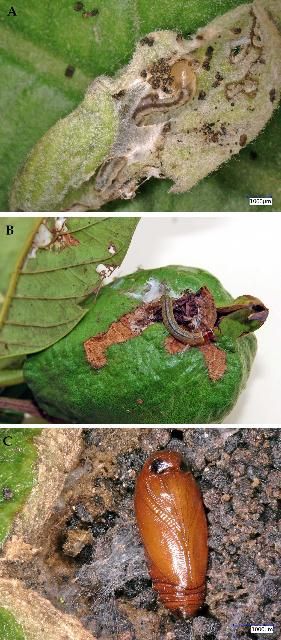
Mealybugs
The coconut mealybug, Nipaecoccus nipae (Makell) is regularly observed in late autumn and early winter. The adult female mealybugs are white, about 3 mm long, and covered with a white, mealy wax. The mealybug shelters in the leaf axils, but they also move onto fruit and settle under the calyx or between fruit that are touching (Figures 7 and 8).
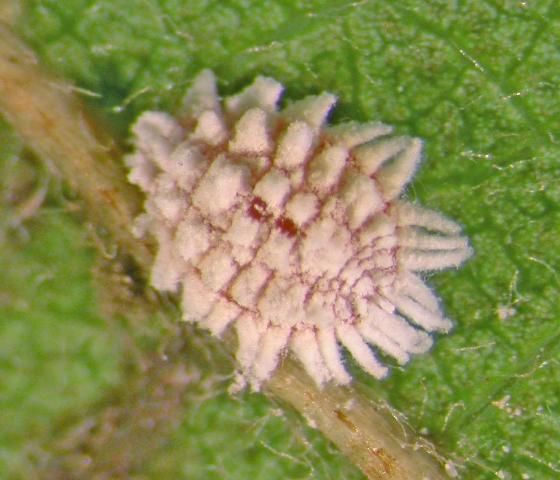
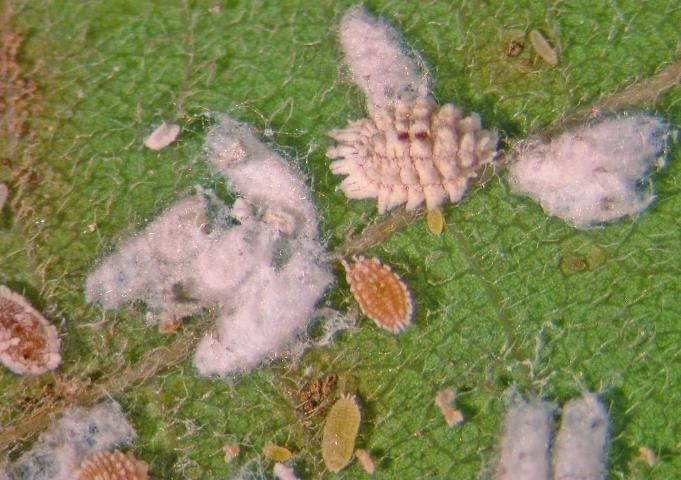
Scales
Hemiberlesia lataniae (Figure 9) is one of several scales that can be found infesting guava fruits others are mostly on the leaves but can also invade the fruit when populations increase.
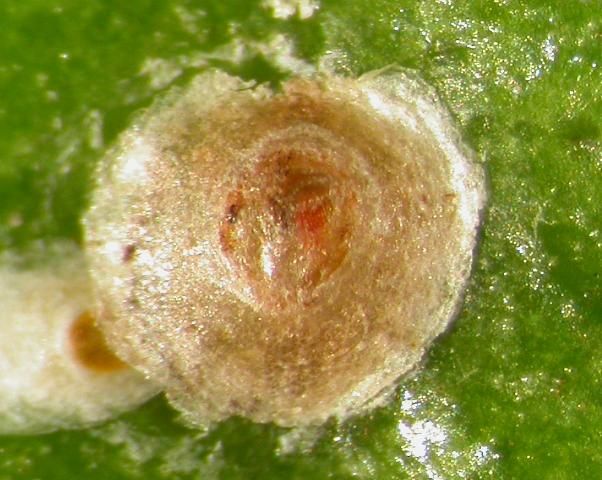
Leaffooted Bugs
Leaffooted bugs (Leptoglossus spp.) are conspicuous insects (20–25 mm long) that make a buzzing sound in flight (Figures 10 and 11). Eggs are laid in a row or chain along a stem or leaves of weeds around the crop or on the crop itself (Figure 12). Ordinarily, leaffooted bugs are considered minor pests, but occasionally large numbers accumulate and cause economic damage. Feeding results in punctures (Figure 13A and B) that allow pathogens to enter the fruit and cause rotting and may result in fruit drop or distorted, poor quality fruit.
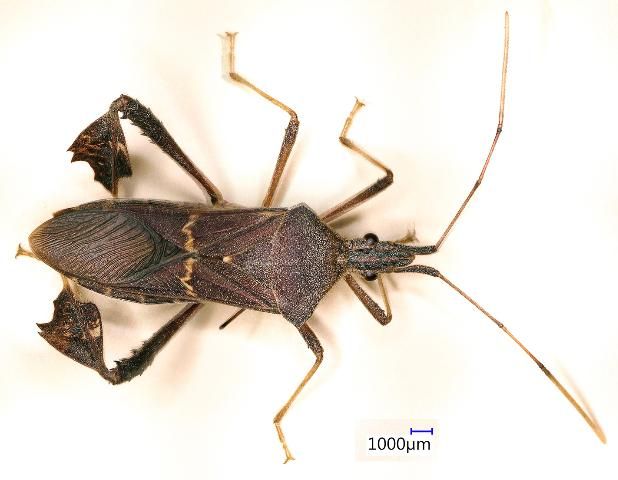
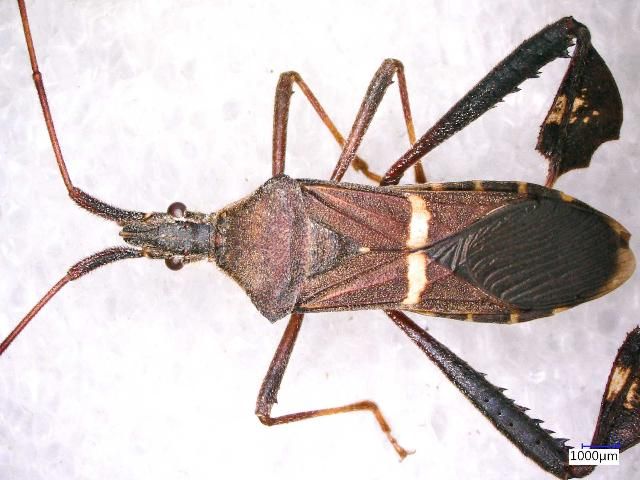
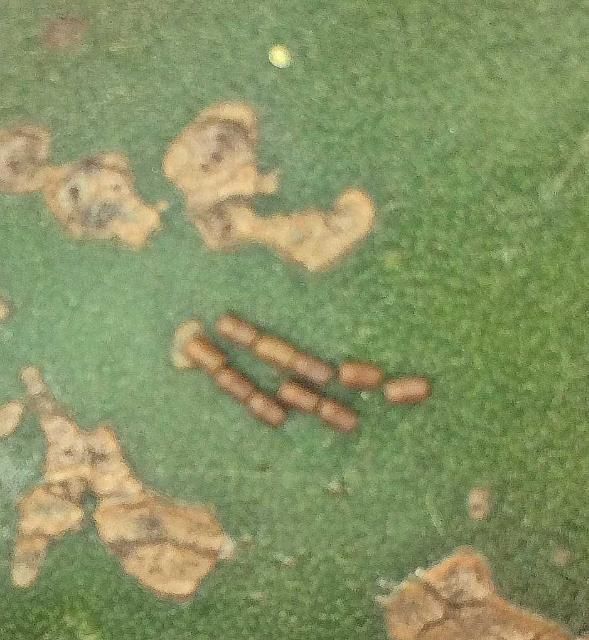
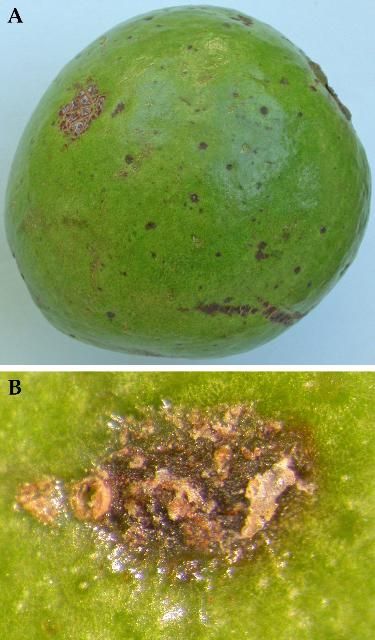
Insects and Mites on Foliage
Thrips
Red-banded thrips are slender, yellowish and with a red band on the abdomen; about 1.5 mm long (Figure 14). Adults are dark brown to black (Figure 15). They can be found on the upper and undersides of the leaves. Red-banded thrips, Selenothrips rubrocinctus (Giard) are often troublesome on guava and may cause defoliation and fruit russeting. When infestations are heavy, thrips feed on the entire surface of the leaves, leaving the leaf with a characteristic silver color. Infested leaves are spotted on the upper surface with fecal deposits that turn reddish brown to black.
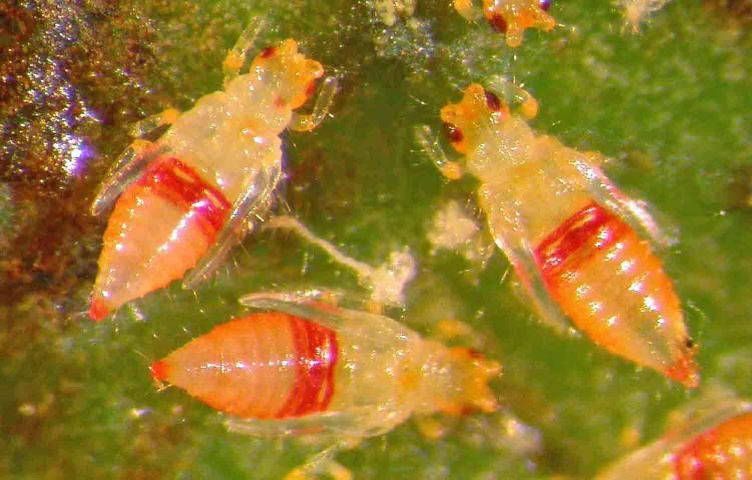

Scales
Several scales infest guava trees throughout the year. Philephedra tuberculosa (Figure 16), Ceroplastes spp. (Figure 17A and B), and the invasive species Phalacroccus howertoni (Figure 18). These scales are most commonly found on the leaves and stems of the tree; they will occasionally become abundant enough to be considered a pest and require control.
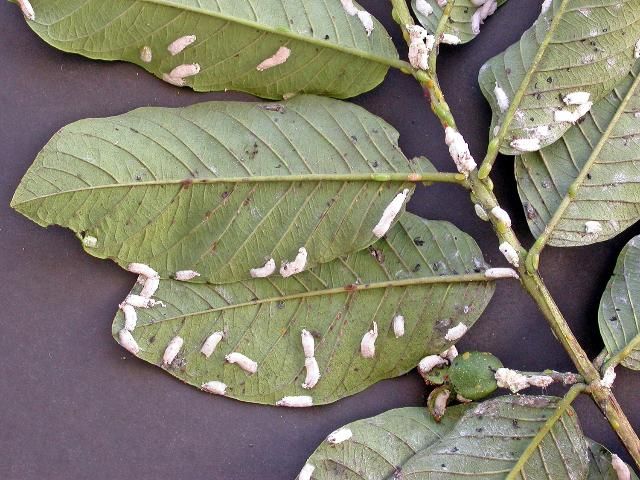
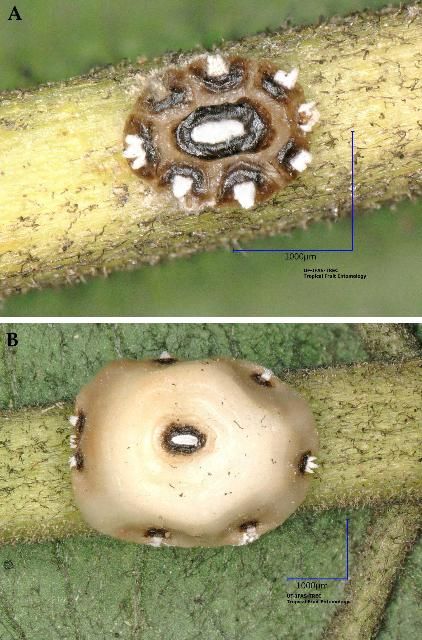
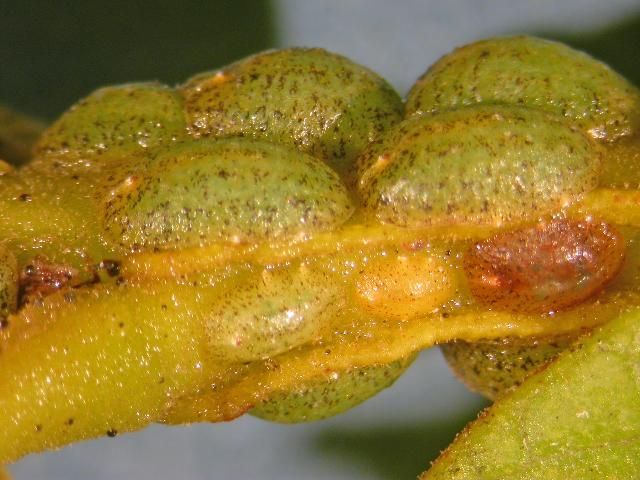
Mites
The mites, Tegolophus guavae, cause damage to fruits and tender leaves. These mites are observed in early autumn, through winter, and during spring months. They are most often observed on small fruit, causing pimples or deformations, followed by fruit bronzing. Mite populations develop resistance to pesticides very rapidly because they have such a short generation time. Soap or oil sprays may be an alternative control measure.
Insects on Stem and Trunk
Scales
The invasive lobate lac scale, Paratachardina pseudolobata (Figure 19A and B), was first found on hibiscus in Florida. It is a polyphagous species, and it has been found damaging stems of guava trees. The female is 1.5–2 mm long.
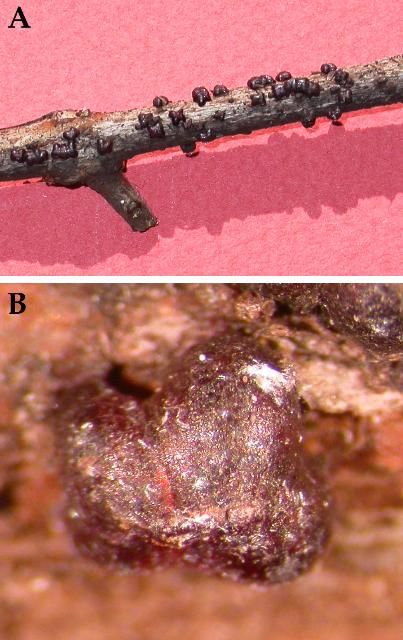
Control, Precautions, and Restrictions
Guavas are subject to attack by several insects; however, only a few have populations at levels high enough to be considered pests. Below is a website that contains control measures to use on an as-needed basis. However, the user must read the pesticide label carefully and adhere to regulations. Your local UF/IFAS Extension office may be able to provide more information on pest control materials.
References
Castineiras A, Peña JE, Duncan R, Osborne L. 1996. Potential of Beauveria bassiana and Paecilomyces fumosoroseus (Deuteromycotina: Hyphomycetes) as biological control agents of Thrips palmi (Thysanoptera: Thripidae). Florida Entomologist 79(3): 458–461.
Duarte IS, Nuñez LB, Peña JE, Pinto L. 2008. Biology, Parasitoids and Damage of Leptoglossus zonatus and Leptoglossus gonagra (Heteroptera: Coreidae) on Citrus. Proc Fla State Hort. Soc. 121.
Jacas J, Gomez A, Peña JE, Duncan R. 2002 Anastrepha suspensa (Loew), Diptera: Tephritidae. Levante Agricola.
Peña JE. 2013. Potential Invasive Pests of Agricultural Crops Wallingford. Oxfordshire: CABI. 440 p.
Peña JE, Duncan R, Vasquez T, Hennessey M. 1999. Guava arthropod seasonality and control of fruit flies in South Florida. Proc Fla State Hort. Soc. 112: 4.
Simmonds TJ, Carrillo D, Burke GR. 2016. Characterization of a venom gland-associated rhabdovirus in the parasitoid wasp Diachasmimorpha longicaudata. Journal of Insect Physiology 91–92: 48–55.